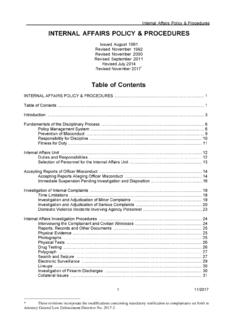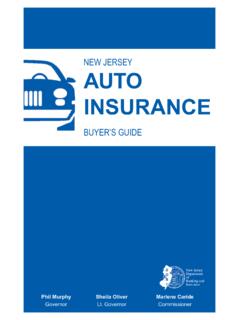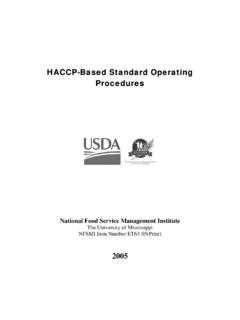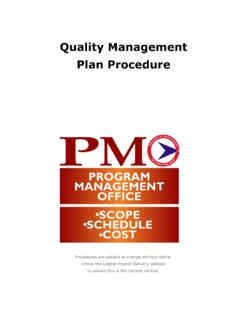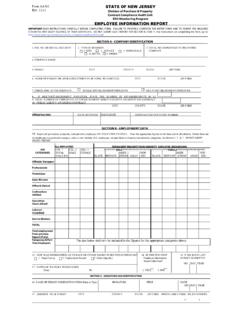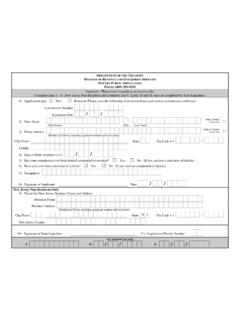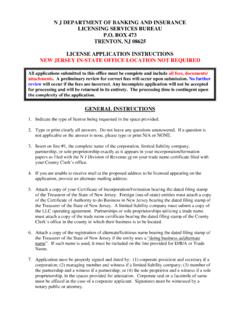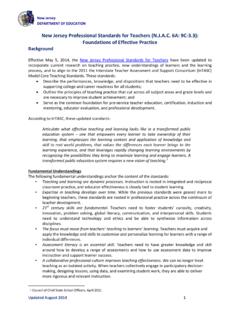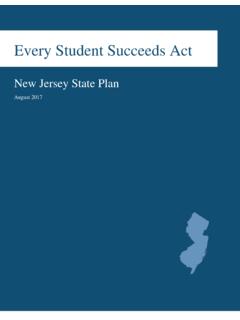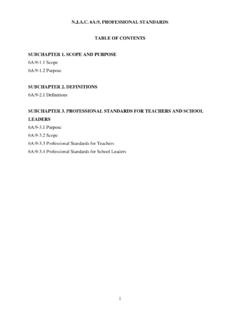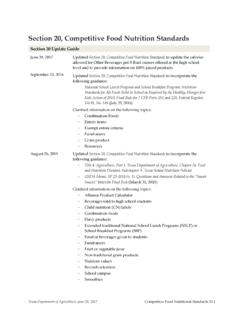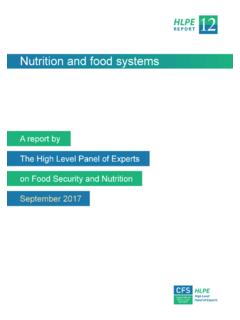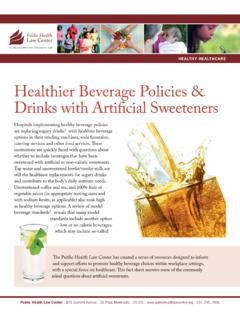Transcription of New Jersey School Nutrition Policy – Questions and Answers
1 New Jersey School Nutrition Policy Questions and Answers FOR ALL GRADE LEVELS: Items that are prohibited to be served, sold or given out as free promotion anywhere on School property at anytime before the end of the School day: 1) Foods of minimal nutritional value (FMNV) as per USDA definition. Q: What are the specific FMNV defined by USDA? A: Soda water, water ices, chewing gum, hard candy, jellies and gums, marshmallow candies, fondants, licorice, spun candy, and candy coated popcorn. Q: Can items on the USDA FMNV exemption list be sold? A: Yes, but only if they meet the NJ Policy standards. The exemption list can be found under the memos/ forms section of the reimbursement voucher website (#16). 2) All food and beverage items listing sugar, in any form, as the first ingredient. Q: What are the forms of sugar that might be listed? A: The forms of sugar may include, but are not limited to: corn syrup, dextrin, fructose, high fructose corn syrup, galactose, glucose, honey, lactose, malt, maltose, maple syrup, molasses and sucrose.
2 Q: What if the first ingredient listed is a component of the product, such as filling ? A: The label will then define the ingredients in the filling, usually in parenthesis immediately following the word filling. If the first ingredient of the filling is a sugar, then the product cannot be sold. [Example: Ingredients: Filling (high fructose corn syrup, corn syrup, apple puree concentrate, etc.)]. Q: Can products that contain artificial sweeteners be sold? A: Yes. However, due to limited research on possible long-term effects of artificial sweeteners, the Division does not recommend their use. Q: Does this sugar restriction apply to items offered as a reimbursable meal component? A: Yes. The sugar standard applies to meal components and to all other food or beverage items. 3) All forms of candy. Q: Are gummy fruit snacks considered to be candy? A: Yes. These products cannot be served or sold. Q: Does this restriction apply to School fundraisers?
3 A: Yes. Candy cannot be sold on School property during the School day. However, it is acceptable to distribute items that have been sold off School property for students to take home. Schools are encouraged to seek other products to sell for fundraising in order to give a consistent message to their students. 1. Snack and beverage standards, including those served in the After School Snack Program 1) No more than 8 grams of total fat per serving, with the exception of nuts and seeds. 2) No more than 2 grams of saturated fat per serving. Q: What is the definition of a snack? A: A snack is considered to be a small portion of food eaten to supplement meals, meal components and entrees. Q: Are these standards based on the contents of a package or on a serving size? A: The standards are based on the serving size. Nutritional information on the nutrient facts labels is always based on serving size. Q: Can packaged items containing more than one serving per package/container be sold?
4 A: Yes, as long as the product meets the fat and saturated fat standards per serving. However, the Division recommends that schools try to be consistent with using only single size serving packages/containers. Q: Are there resources available to identify snacks and beverages that meet these standards? A: Yes. Many companies have already developed snacks to meet the standards. Contact the vendor, company website or local sales representative for the availability of products and Nutrition information. Q. Do School baked desserts have to meet the fat standards, also? A. Yes, the recipes used must be nutritionally analyzed and schools may not serve baked desserts that exceed the Policy fat standards, per serving. Q: Since nuts and seeds are exempt from the fat standard, would products that contain nuts or seeds, such as granola bars with nuts, also be exempt from this standard? A: No. This exemption only applies to nuts and seeds in their natural or shelled state.
5 Q: Why do these standards apply to snacks provided as an after School snack, if this Policy is only applicable to items sold or served during the School day? A: The standards apply to snacks served within the federally funded After School Snack Program because this is a reimbursable program under the jurisdiction of the NJ Department of Agriculture. Q: Do these standards apply to the School meal components? A: No. The standards are for snacks and beverages. The School meals are already required to meet nutritional standards established by the US Department of Agriculture. Q: Can a reimbursable meal component that may not meet the Policy 's standards, such as French fries or peanut butter and jelly sandwiches, be sold a la carte? A: Yes, as long as the item is sold in the same portion size as offered in the meal. The Division strongly recommends that every effort be made to select menu items that are lower in fat and saturated fat, as recommended by the Dietary Guidelines.
6 2. 3) beverage sizes, other than water, or other than milk containing 2 percent or less fat, shall not exceed twelve (12) ounces. Q: Why are beverages being restricted in size? A: Oversized portions encourage students to consume more calories, which can contribute to them becoming overweight and undernourished. Larger drinks may replace calories that could otherwise be consumed from eating healthier foods. Q: Since 100% juice is considered a healthy beverage option, why is it being restricted in size? A: Although 100% juices proved a good source of vitamins, current research recommends limiting the quantities of these beverages for children because of their naturally high sugar content. 4) Whole milk shall not exceed 8 ounces. Q: Why is whole milk restricted to an 8- ounce portion? A: The Dietary Reference Intake recommends that children consume no more than 25-35%. of calories from fat. Because of the high fat content of whole milk, larger portions could easily result in exceeding these recommendations.
7 Q: Does this apply to all flavors of whole milk? A: Yes. However, any flavor of milk that contains 2% or less fat may be offered in any size. Schools shall reduce the purchase of any products containing trans fats. Q: Does this trans fat recommendation apply to oil used in fryers? A: Yes. Every effort should be made to reduce the use of any products containing trans fats. Labeling for trans fat content will be mandatory by January 2006. FOR ELEMENTARY SCHOOLS: 100 percent of all beverages offered shall be milk, water or 100 percent fruit or vegetable juices. Q: Can flavored waters, either naturally or artificially sweetened, be sold? A: Yes, any type of water may be sold. However, the Division strongly recommends that schools examine the products' ingredient and nutrient facts labels and limit the offering of waters containing sugars and artificial sweeteners. Q: Can individual portion pack mixers (liquid or powder form) designed to be added to water, be sold?
8 A: No, not in elementary schools. Q: Can sparkling waters be sold? A: Yes, only if USDA has exempted the product from being classified as a Food of Minimal Nutritional Value (FMNV). Again, though, the Division strongly recommends that schools limit the offering of waters that contain added sugars or artificial sweeteners. 3. FOR MIDDLE AND HIGH SCHOOLS: At least 60 percent of all beverages offered, other than milk and water, shall be 100 percent fruit or vegetable juices. Q: When determining these percentages of beverages offered, do standard principles of rounding apply? A: No. Refer to the Division's beverage Reference Chart for determining the mix of beverages that can be offered. The chart will be posted on the Division's reimbursement voucher website. Q: If the district offers the following products: peach tea, lemon tea, raspberry tea, and diet lemon tea, would that count as one variety toward the 60%/40% beverage standard?
9 A: No, it would not count as one variety. Each tea would be considered a flavor/variety, thus, in that scenario the district would have four varieties. Q: Does this 60/40 percent mix of beverages apply to the entire School , or to each location where beverages are offered? A: Each location ( serving line, vending machine, store) must apply the 60/40 percent mix of beverages. Q: Can individual portion pack mixers (liquid or powder form) designed to be added to water, be sold? A: Yes, but they must be included as part of the 40% of other beverages that can be offered. Q: Can coffee be sold or served? A: Yes. Coffee would be part of the 40% of other beverages that a School could sell. Q: Are milkshakes and smoothies considered to be beverages? A: Yes. They must meet the beverage standards within the Policy . No more than 40 percent of all ice cream/frozen desserts shall be allowed to exceed the above standards for sugar, fat and saturated fat.
10 Q: When calculating the 40% of other ice cream products that can be offered, do standard principles of rounding apply? A: No. Refer to the Division's Ice Cream Reference Chart for determining the mix of items that can be offered. The chart will be posted on the Division's reimbursement voucher website. 4. EXCEPTIONS TO THE Nutrition STANDARDS: Food and beverages served during special School celebrations or during curriculum related activities, except for Foods of Minimal Nutritional Value as defined by USDA. Q: Can teachers use food for incentives or rewards? A: Yes, but the items must meet the Policy 's standards. The Division recommends that teachers not use food in this way, but rather that they find alternatives such as stickers or tokens that can be redeemed for prizes. Research has shown that using food items for rewards can negatively impact students' healthy attitudes toward eating. (Fit, Healthy, and Ready to Learn: A School Health Policy Guide, Part 1, Chapter E, pages 15-16).
